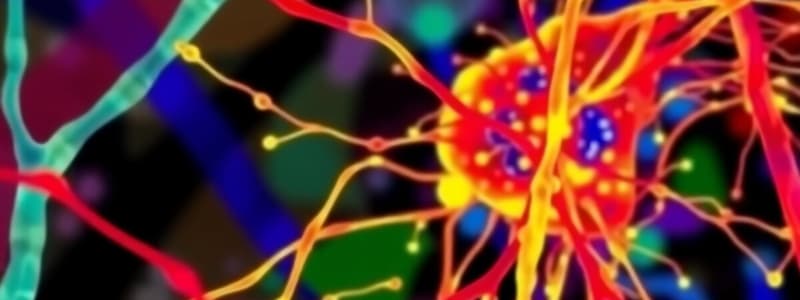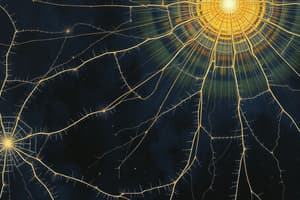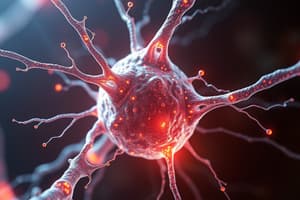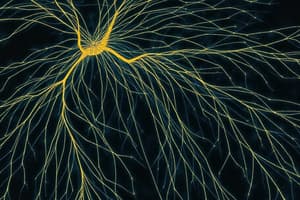Podcast
Questions and Answers
A microtubule protofilament is formed by the:
A microtubule protofilament is formed by the:
- lateral association of only 9-tubulin subunits.
- head-to-tail association of tubulin dimers. (correct)
- head-to-tail association of only 9-tubulin subunits.
- lateral association of tubulin dimers.
In cells, the 9-tubulin ring complex is found:
In cells, the 9-tubulin ring complex is found:
- along the outer wall of the microtubule.
- at the microtubule (+) end.
- in the hollow core of the microtubule.
- at the microtubule (-) end. (correct)
The alpha and beta tubulin proteins can bind:
The alpha and beta tubulin proteins can bind:
- to ATP or ADP.
- to GTP or GDP.
- only to GDP.
- none of the above (correct)
Where are microtubules observed to be present in different polarities?
Where are microtubules observed to be present in different polarities?
At MTOCs, microtubule nucleation is facilitated by:
At MTOCs, microtubule nucleation is facilitated by:
Growing microtubule ends are normally stabilized by:
Growing microtubule ends are normally stabilized by:
The drug taxol acts to:
The drug taxol acts to:
A drug that prevents microtubules from depolymerizing could be used to:
A drug that prevents microtubules from depolymerizing could be used to:
Microtubule assembly requires:
Microtubule assembly requires:
MAP2 and Tau are examples of microtubule:
MAP2 and Tau are examples of microtubule:
The EB1 protein has several functions. Which of the following is/are true regarding EB1?
The EB1 protein has several functions. Which of the following is/are true regarding EB1?
Which of the following is NOT a way in which a microtubule switches from growing to shortening?
Which of the following is NOT a way in which a microtubule switches from growing to shortening?
The region of a motor protein that interacts with the motor's cellular cargo is the:
The region of a motor protein that interacts with the motor's cellular cargo is the:
All of the following statements describe kinesin-I EXCEPT:
All of the following statements describe kinesin-I EXCEPT:
The ______ serves as a template for the unusual structure of axoneme microtubules.
The ______ serves as a template for the unusual structure of axoneme microtubules.
For kinesin motors, the direction of movement along a microtubule is specified by the motor's:
For kinesin motors, the direction of movement along a microtubule is specified by the motor's:
Which of the following is true regarding the transport of cargo by cytoplasmic dynein?
Which of the following is true regarding the transport of cargo by cytoplasmic dynein?
The force for axoneme bending is derived from the:
The force for axoneme bending is derived from the:
The primary cilium:
The primary cilium:
Which of the following is NOT true about cilia?
Which of the following is NOT true about cilia?
Separation of spindle poles during spindle formation and anaphase B most likely depends on which of the following?
Separation of spindle poles during spindle formation and anaphase B most likely depends on which of the following?
Which of the following occurs during anaphase A?
Which of the following occurs during anaphase A?
In the mitotic spindle, astral microtubules function to:
In the mitotic spindle, astral microtubules function to:
Treadmilling through kinetochore microtubules can be observed by:
Treadmilling through kinetochore microtubules can be observed by:
Kinetochores assemble at the:
Kinetochores assemble at the:
Capture of microtubule (+) ends by chromosomes occurs during:
Capture of microtubule (+) ends by chromosomes occurs during:
Poleward movement of chromosomes during anaphase A requires:
Poleward movement of chromosomes during anaphase A requires:
Which of the following does NOT belong to the intermediate filament protein family?
Which of the following does NOT belong to the intermediate filament protein family?
The important role that intermediate filaments play in the epithelial cells of the skin is evident in which of the following?
The important role that intermediate filaments play in the epithelial cells of the skin is evident in which of the following?
Which of the following is true about intermediate filaments?
Which of the following is true about intermediate filaments?
Flashcards
Microtubule protofilament structure
Microtubule protofilament structure
A head-to-tail assembly of tubulin dimers forming a cylindrical structure within a microtubule.
g-tubulin ring complex location
g-tubulin ring complex location
Located at the minus (-) end of a microtubule, facilitating microtubule nucleation.
Microtubule Organizing Center (MTOC)
Microtubule Organizing Center (MTOC)
Structure from which microtubules originate in most cells, with their minus ends usually staying associated with the MTOC.
Microtubule growth stabilization
Microtubule growth stabilization
Signup and view all the flashcards
Taxol's effect on microtubules
Taxol's effect on microtubules
Signup and view all the flashcards
Consequences of GTP cap loss
Consequences of GTP cap loss
Signup and view all the flashcards
Colchicine's effect on cells
Colchicine's effect on cells
Signup and view all the flashcards
Dynein's direction of transport
Dynein's direction of transport
Signup and view all the flashcards
Kinesin-I and Cytoplasmic Dynein (cargo transport)
Kinesin-I and Cytoplasmic Dynein (cargo transport)
Signup and view all the flashcards
Axoneme bending mechanism
Axoneme bending mechanism
Signup and view all the flashcards
Primary cilium characteristic
Primary cilium characteristic
Signup and view all the flashcards
Intermediate Filament Protein Family
Intermediate Filament Protein Family
Signup and view all the flashcards
Nuclear Lamina Disassembly
Nuclear Lamina Disassembly
Signup and view all the flashcards
Study Notes
Microtubules and Intermediate Filaments
- Microtubule protofilaments are formed by the head-to-tail association of tubulin dimers.
- The 9-tubulin ring complex is located at the microtubule's minus (-) end.
- Most microtubules originate in the microtubule-organizing center (MTOC).
- Microtubule protofilaments are head-to-tail assemblies of tubulin dimers, with 13 composing the microtubule wall.
- Alpha and beta tubulin subunits bind GTP or GDP, but not to ATP or ADP.
- Tubulin subunits are normally stabilized by a GTP cap.
- The drug taxol stabilizes microtubules against depolymerization.
- Loss of a GTP cap causes a microtubule to switch from growth to shortening.
- Colchicine blocks microtubule assembly.
- Microtubule assembly requires ATP.
Microtubule Nucleation
- Microtubule nucleation is facilitated by g-tubulin at the microtubule-organizing centers (MTOCs).
- Growing microtubules are typically stabilized by a GTP cap.
- Microtubules can originate from centrioles or basal bodies, which are usually part of the MTOC.
Motor Proteins
- Motor proteins like kinesin and dynein use ATP hydrolysis to move along microtubules.
- Kinesin typically moves toward the plus (+) end of a microtubule.
- Dynein typically moves towards the minus (-) end of a microtubule.
- Dynactin links dynein to microtubules.
- Neuronal vesicles may contain both kinesin and dynein for bidirectional transport along microtubules.
Intermediate Filaments
- Intermediate filaments are a type of cytoskeletal protein.
- Keratin, vimentin, and desmin are examples of intermediate filament proteins.
- Laminin is NOT an intermediate filament protein.
- Intermediate filaments are important for mechanical strength of cells, especially in epithelial cells.
- Intermediate filaments are stable and don't typically exhibit dynamic instability.
- During mitosis, intermediate filaments are disassembled and then reassembled.
Studying That Suits You
Use AI to generate personalized quizzes and flashcards to suit your learning preferences.




